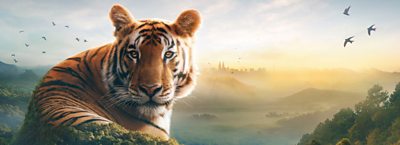Sir David Attenborough presents Asia, a seven-part series exploring the amazing wildlife and natural wonders of our planet’s largest continent.
Across seven episodes exploring each corner of this remarkable part of our planet, audiences will journey through Asia’s most stunning landscapes, witness a wealth of wildlife, and uncover stories of extraordinary unseen animal behaviour. Filmed over the course of nearly four years, this is the first time that Asia - home to the highest mountain range, the deepest ocean, the tallest jungles, and the biggest cave - has been the focus of a landmark �鶹�� wildlife series.
In Nepal, we’ll follow rhinos playing ‘kiss chase’ in a bizarre courtship ritual. In the foothills of the Himalaya, amidst forests of bamboo, we’ll meet Asia’s shyest and possibly cutest mammal: the red panda. Five thousand metres up on the Tibetan Plateau, we’ll witness a lone wolf relentlessly hunting a herd of antelope for hours on end.
In Sri Lanka, we’ll join elephants that have learnt to become highway thieves – holding up buses to get food from the passengers. And in the rich waters of the Western Pacific, we’ll swim with sea snakes that have learnt to team up with fish to hunt.
Asia will also explore the conservation challenges facing the continent, and shine a light on the potential solutions being championed by the region’s conservation heroes. From the vast Gobi Desert, to the jungles of Borneo, and from the polar wilderness of Siberia to the coral seas of the Indian Ocean, this series will showcase the breath-taking diversity of Asia’s wildest places.
Asia, a 7x60’ for �鶹�� One and iPlayer, is made by �鶹�� Studios Natural History Unit, co-produced with �鶹�� America, France Télévisions and ZDF. It was commissioned by Jack Bootle, Head of Commissioning, Specialist Factual. The Executive Producer is Roger Webb, the Series Producer is Matthew Wright and the Commissioning Editor is Sreya Biswas, Head of Commissioning, Natural History.
FS
When is Asia on TV and �鶹�� iPlayer?
Watch Asia on �鶹�� iPlayer from Sunday 3 November and add to your Watchlist now.
Watch Asia on �鶹�� One from Sunday 3 November at 6.20pm.
Watch the Asia Trailer
Asia Episodes
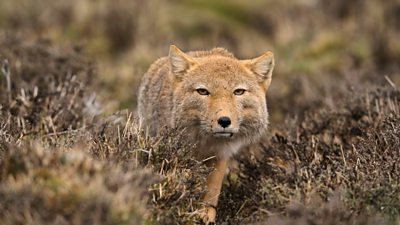
Episode 1 – Beneath The Waves
Asia has the longest coastline of any continent, and the most abundant coral reefs on Earth. Its seas are connected by some of the world’s most powerful currents, and are home to over sixty percent of all marine species. This ground-breaking film features the charismatic creatures of Asia's oceans, never- seen-before spectacles and brand-new animal behaviour. From giants in the deep ocean, to tiny fish that climb trees, squid that glow in the dark, and grey reef sharks that hunt in their hundreds. Asia’s waters are as spectacular as they are diverse.
Episode 2 – Above The Clouds
Asia is the most mountainous continent on earth. From the forested slopes of the tropics to the hostile heights of the Himalaya, Asia’s mountains are home to an astonishing abundance of specialised plants and wildlife. In India, elephants live in high-altitude tea plantations; and in Thailand, mountainous caves hide the planet’s greatest gathering of swifts. In Pakistan, markhor live life truly on the edge, fighting for mates atop towering cliffs; and in Nepal, the forested foothills of the Himalaya provide hiding places for one of Asia’s shyest but most adorable mammals, the red panda.
Episode 3 – The Frozen North
In northern Asia, life defies hostile extremes. In Russia's Lake Baikal, a seal pup must take evasive action when its ice den starts to melt. Hokkaido's thermal springs are a haven for dancing red-crowned cranes. On the Tibetan Plateau, a lone Himalayan wolf hunts antelope. Fish owls thrive in the forests where Russia and China meet. On the Kamchatka Peninsula, brown bears hunt salmon in preparation for winter. Elsewhere in Japan, bats hibernate beneath snow, while red foxes and sea eagles compete for food. In Arctic Russia, polar bears wait on isolated islands for the return of sea ice.
Episode 4 – Tangled Worlds
Asia’s jungles are exceptionally diverse, but whilst they provide shelter, food, and opportunity, they are also full of dangers and hidden threats. In monsoon forests, tigers tenaciously hunt their prey, and prehistoric-looking rhinos play courtship games akin to kiss-chase. In tropical rainforests, female orangutans must search far and wide to find their perfect mates. And in the little-known forests of Iraqi Kurdistan, a new Persian leopard population is growing amidst minefields.
Episode 5 – Crowded Continent
In Asia, the most densely populated continent, animals have developed extraordinary ways to seize the opportunities of the human world. From tigers entering a city to hunt easy prey, to elephants stopping traffic to demand food from motorists. A small park in central Bangkok supports three hundred giant lizards whilst a flying squirrel in Taipei has made a cosy home in a school. Yet, the changing human world creates unprecedented challenges: proboscis monkeys are forced to venture uncomfortably closer to humans and swifts in Jerusalem face tough competition for nest sites.
Episode 6 – The Arid Heart
In the heart of Asia lie vast arid lands. These deserts and dry grasslands are so hostile, they push life to the limit. Here, one of the rarest animals on earth, the Gobi Bear, searches desperately for water, and bizarre looking long-eared jerboas use their striking features to catch insects. Asiatic lions must do whatever it takes to find food and juvenile cormorants resort to cannibalism to survive. On the arid grasslands, Pallas cats need ingenious ways to get close to their prey, Mongolian Gazelles must battle harsh winters and human barriers, and takhi horses are terrorised each night by Mongolian wolves. Life in the Arid Heart demands extraordinary resilience - those that live here are Asia’s great survivors.
Episode 7 – Saving Asia
Remarkable people are dedicating their lives to saving Asia’s extraordinary wildlife, using ingenious solutions. In Borneo, we follow a sun bear being released back into the wild; and in Java, we see how a breeding programme is saving the Javan green magpie. In Japan, orphaned shark embryos are being raised in an artificial uterus. And off Bali, fishermen are trialling new technology that could stop rare species being caught in their nets. We witness a Nepali police raid disrupting the illegal wildlife trade, and also join a 24-hour wildlife rescue team saving Sunda pangolins in urban Singapore.
Asia in Numbers
- Total number of filming days: 2,287
- Total number of shoots: 120 shoots
- Total number of countries filmed in: 21 countries
Interview with Roger Webb (Executive Producer)
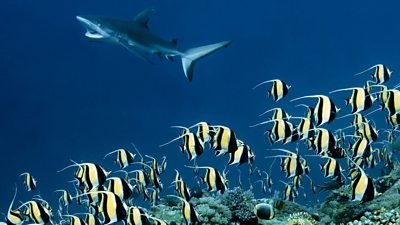
What was the genesis of this series?
The Natural History Unit made the series Seven Worlds, One Planet, five years ago now. The team on that did a tremendous job. And obviously one of the episodes was Asia, which did really well. It became clear that there are so many stories there beyond what was possible to do in a single hour for Seven Worlds, One Planet.
Everybody who was involved in that particular episode just kept talking about it and the riches that were on offer there. Then it came to light that no one's really done an in-depth series about Asia and its wildlife, taking the continent as a whole. So we started doing more work collating what other stories might be possible and realized we had such a rich list. Also, there’s a certain mystique and romance about Asia.
So many of the places in Asia are on people's bucket lists to visit. You've got that element as well as an incredible cast of animals in incredible places. So we took it to �鶹�� Commissioning, and they were similarly excited about what we proposed. No disrespect to any other continent on the planet, but as Sir David says at the top of the series, there's nowhere with more untold stories.
For us as wildlife filmmakers, there's nothing more exciting than that. So that was it. We were just energized and excited. We ran with it, and we've had the most amazing four years making the series. The team have done an incredible job.
Why have these stories from Asia been untold for so long, do you think?
When people think of wildlife or wild places, they don't necessarily jump straight to Asia. But the animals you find in Asia are as big and as charismatic as any you might find in Africa. There are rhinos there, there are elephants, there are, of course, tigers. There are also lions, which I don't think some people realise. So the riches on offer are on a par with anywhere else in the world.
But for whatever reason, our cameras have not heavily focused on those animals in Asia before. So it’s just such an exciting opportunity for us. Also, technology has moved on so fast in the last five or ten years. To be able to apply that to filming stories that have rarely been told or not told at all is just super exciting for us.
What does Sir David’s involvement add to the project?
David brings so much to anything we do. We were so pleased having him voice Asia. I think he was similarly excited about the stories. It's always lovely when you get feedback from David and he says, “Oh, I really enjoyed that.” For example, he loved the Moorish idol sequence with the sharks in the Oceans episode “Beneath the Waves.” His enthusiasm never seems to dwindle. If you're getting a big smile and a thumbs up from Sir David, you’re in a good place!
He's been an absolute delight to work with. He's painstakingly gone through every script and fed back to us. He interrogates every word and will review things in great detail. It’s been a great dialogue. Together we've been truly able to hone the scripts. He's 98, and his performance in the commentary is as good as anything I've heard before. He still has the same hunger that I believe he had all those years ago. He motivates us as well, which is lovely. To work with him is an honour. He's an incredible human being, and it's just so fantastic to be working with him again on this.
Which sequences stand out for you in this series?
The opening sequence in the whole series where a school of Moorish idols are chased by grey reef sharks is quite extraordinary. That has been on quite a few wildlife filmmakers’ bucket lists, but producer Mark [Wheeler] really went for it. He will probably say he got lucky, but he planned everything down to the nth degree, and he worked with a brilliant team. They managed to capture something that's never been captured before. The fish themselves are beautiful.
They're little characters with their pursed lips. They remind me of some of the fish in Finding Nemo. They are just instantly charismatic. Then the sharks are also remarkable. The way they pursue the Moorish idols en masse in this frenzy is amazing. The energy and the music and, of course, Sir David's narration combine with that to create a very powerful and engaging sequence. It is an incredible story, and it really sets us up on the right path for the series.
Which other highlights would you pick out?
The cave swifts in Thailand which feature in the Mountains episode, “Above the Clouds”. That is an amazing spectacle in itself. It's the greatest concentration of swifts anywhere on the planet. But as they're nesting in this cave, there’s a little twist to the story. In the water that sits at the bottom of the cave are these big catfish. They are not just minding their own business. They're looking for a chance to feed. As the swifts duel for a nesting site, they do on occasion fall into the water, and that's a dangerous place for them to be with these big fish lurking there. Of course, the fish are ready. They're waiting for these opportunities.
If there are any ripples in the water, they literally pounce upon them. The poor swifts are basically helpless in the water, doing their best to flap their wings and try to get out. But within moments, they're dragged beneath the surface and disappear from view. Not only is that incredible behaviour - and to be able to document for the first time is amazing - but it’s also a very powerful story. And yes, of course, we feel for the swifts who are taken, but millions do make it through. And ultimately, theirs is a success story. It’s a great sequence, really well filmed by the team led by the producer Sara [Douglas].
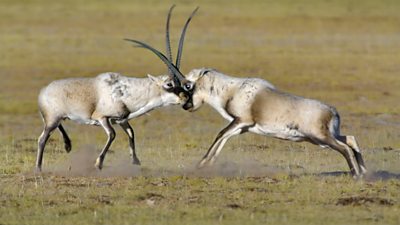
What other outstanding sequences should viewers look out for?
For “The Frozen North” episode, we set out to film the chiru, an antelope that you find on the Tibetan plateau. We went there during the rutting season. They themselves are spectacular animals, and they live in this incredible, barren place over 4,000 meters. It's a very tough place to live. We embarked on a mission to document the rutting of the chiru, and our cameraman Jacky Poon wasn't having the best of luck. Then one day he came across this lone wolf. In itself, it was amazing to see this wolf, but then Jacky realized it was quite happy for him to follow it around. So Jacky stuck with this lone wolf, and lo and behold, it started hunting the chiru.
Jacky managed to film the most incredible hunt sequence with this wolf running and running and running, hour after hour, wearing the chiru down. The chiru are actually faster than the wolf, but the wolf has more stamina, and eventually this lone wolf manages to pick off one of the chiru. It's almost like a test of the fitness of the chiru, and sure enough, as one tires, the wolf is able to take it down. Jacky shot that using drones. The light was fading. The battery was fading. It had all the classic cliches of filmmaking.
Everything was reaching that moment where the team was thinking, “Are we going to get this or not?” But they did get it, and it is a very special and powerful sequence. Full credit to Jacky and the team who worked so hard in a very tough place, where just sleeping and getting around is really difficult due to the altitude and the extremely cold conditions. But all their effort paid off. They have filmed an incredible sequence.
What do you hope audiences will take away from this wonderful series?
A new appreciation of Asia. I hope they will see it through a slightly different lens. The wildlife in Asia is on a par, if not even more incredible than anywhere else in the world. It’s colourful, it's diverse. The range of habitats is really remarkable. From the frozen north to the baking hot desert, the variety within this single continent is incredible.
It is a world within a continent. It's got everything that the planet has. It’s got the highest mountains, the deepest ocean, the tallest rainforest trees. It's an incredible place with a great cast of characters and animals. It truly is an amazing continent with so many riches. It has a feeling all of its own. It's very different to anywhere else. Really, it has a kind of magic about it. I believe that comes through in what we've produced. It’s genuinely a special place.
These landmark series are popular all over the world, aren’t they?
Absolutely, they’re sold across the world. I flew to the Middle East last week, and our last series Mammals was available on the plane. That was lovely. It's very gratifying to see how popular these series are all over the world. I almost wanted to nudge the person sitting next to me on the plane and say, “Would you like to watch that?”
Interview with Matthew Wright (Series Producer)
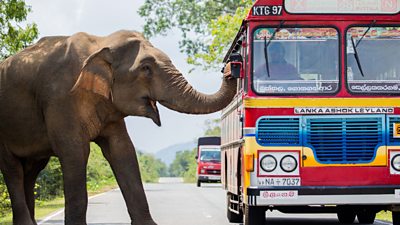
How did this series come about?
The Natural History Unit hasn't devoted a full landmark series like this to Asia before. It feels that Asia is a continent that's looming large internationally. It now contains more people than the rest of the planet put together. Having such a huge size and a huge reach north, south, east, west, it's got an unparalleled array of animals. There are some well-known animals.
Obviously, Asia's got these big familiar box office animals, tigers and elephants and polar bears, and so on. But there's also a cast of unsung heroes, and we've tried to focus on creatures that we may not have seen before. We are also showing well-known creatures doing things that we're not familiar with like tigers in a city or elephants looking for food on a bus. It's fresh to the audience and shining a light on a part of the planet that's been underserved. It’s really exciting to bring all that to viewers.
It’s also showing a different side of Asia, isn’t it?
Definitely. If you said, even to those of us who are fairly well travelled, “What's your association with Asia?”, one would probably go with something like the beaches of Thailand. You wouldn't necessarily immediately think about the Arctic Circle, about being east of the Wallace Line and very close to Australia. Asia extends right to the edge of Africa– parts of Egypt are in Asia. It goes that far to the west. It’s astonishing. It's just huge, it really is. And it has this great diversity. You've got more species of big cat and bear in Asia than in Africa.
Can you talk a bit about the tigers in the city?
They’re amazing. They live in Bhopal which is really quite an industrial city. There's this small but definite group of tigers that have set up home just on the outskirts in an area of scrubby parkland. They are reliably there. They're very much active. When humans aren't active, they avoid us. They stay out of the way.
A lot of people in Bhopal are not really aware of the fact that the tigers are there. So you've got people having picnics and setting up marquees and having a barbecue during the day. Then they pack up and go home, and a couple of hours later, tigers are walking through that same area. It’s obviously something we are hoping stays the same. So far there hasn't really been any great human conflict with the tigers there.
Was it difficult to film that tiger sequence?
Yes. It was hard-won. The crew had to spend months and months there to get six or seven minutes of footage. We knew the mother tiger was there, and then she became pregnant near the beginning of filming. So then we were really hopeful she would have cubs, which she did. That’s a real triumph for the producer that she managed to film that. But we never would have achieved that without the Indian crew. They have been documenting those tigers for a number of years.
So they knew exactly where the best places were to put the cameras. That is something that has been true throughout this series. We've used an enormous number of local crews across the board. That's something that's changed. Since Covid, our units have had to rely more and more on local crew because we can’t always get to locations. As a result, excellent local talent has increased across the planet. We couldn't have made this series without local crews. It’s really important to make that point.
Can you talk us through the sequence where elephants are taking food from people on buses in Sri Lanka?
We featured elephants three times, which we felt was justifiable because they're so charismatic. Elephants are not animals you expect to see beside buses. But elephants are obviously very clever, and they've learned that on this particular road to a temple, most of the pilgrims are going with fruit and other offerings. So the elephants have realised that they have got these vehicles running up and down this route which seems to provide an endless supply of fruit, and the people tend to feed them.
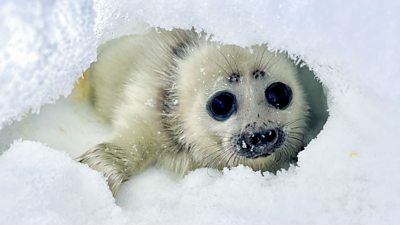
It must have been quite a different type of shoot.
Absolutely. For the crew, it was amazing. Normally, the problem with animals is scaring them off and having to hide and wait for them to turn up. But in this case, it was the opposite. The elephants were there all the time! In the making-of section at the end, we show just how difficult it was to film the elephants there because we really couldn't control those public buses at all. So the crew just had to ride up and down on the buses.
I think they spent quite a bit of money on tickets until they got the interaction they wanted. Everyone seems to be very engaged with that sequence. I suppose it's partly that we all know what it's like getting a bus, and that speaks to us in the West. Then an elephant pops up and we realize we're in a different place!
Do you have other favourite sequences?
One of my absolute favourites is in The Frozen North episode. It features these little birds feeding on sap icicles. It's got an edge to it because those birds might not live if they didn't get to the sap icicles. Although it's hard to capture on film, it is an incredible environment. You could just sit and watch those birds for hours.
They are filmed in super slow motion, and you can just appreciate their anatomy as they manoeuvre around the icicle to lick it. There is something incredibly beautiful and Zen about that. It’s charming and it's new. I haven't seen anything like that anywhere before.
Are there any other sequences you’d like to highlight?
Yes. We filmed in Lake Baikal, which is a frozen wilderness. You get this particular Baikal seal there which you don't find anywhere else on the planet. It’s very tough for the mothers raising their pups. They have to nurse them in these ice dens. Gradually, as the weather warms up, the ice dens collapse, and the pups are pushed into the water beneath. We filmed this incredible piece of behaviour that again we don't think has been documented before and is actually new to science.
The mother seal has to take its pup beneath the ice, but there's no oxygen to be found for a good distance. The pup can't hold its breath for as long as the mother. So the mother appears to do this astonishing thing where she exhales the air that she's holding in her lungs, creating small pockets of air beneath the ice. The pup is then able to go up to where this air pocket sits and breathe in the exhaled air from its mother, which is quite the most remarkable survival strategy. It allows the pup to cover the same distance under the ice as its mother because obviously it hasn't got the same lung capacity.
To witness and to document that is quite incredible. And it's all the more powerful when you think you're seeing things that people haven't seen before and are new to science. More and more when we step into these places with the technology we now have, we can not only tell powerful stories, but we can also add to our understanding of these animals. And obviously, the more we understand them, the more we can help conserve them. To document something new and revelatory like that is a real buzz. It's very exciting to be able to bring that to the screen.
Why have series such as Asia been such a hit all over the world?
We are all driven by story, aren't we? Whether through watching soap operas or feature films or sport, we crave stories, and the natural world provides that in spades. When we set out to film, we often don't quite know what we're going to get. But we're normally pretty confident that some sort of a story is going to emerge because the natural world just delivers that again and again. The series also provide escapism on a Sunday night.
They make us wonder, “What would it be like if I went there?”. It's just the sheer beauty of the natural world as well. In a lot of our day-to-day lives we interact somewhat less with the natural world than we used to. We're all very busy, and the natural world is less accessible. So these series just remind us that we do share the planet with an awful lot of quite remarkable life forms. A series like Asia just offers that sheer sense of wonder.
